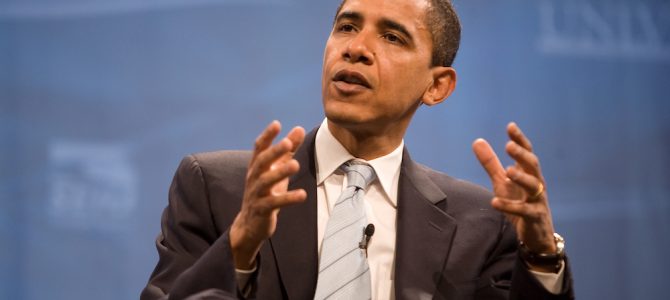
President Obama is accidentally championing conservative energy policy lately: he’s promoting affordable energy and a healthy economy, even while announcing excessive spending commitments based on contested science.
The president rolled out a string of environmental initiatives that allocate $40 million to island and coastal communities “threatened” by erosion that his administration claims is linked to climate change. Almost $10 million will go to small foreign nations, with no benefit whatsoever to American cities or citizens.
Obama announced the initiatives before joining the G20 Summit, where he formally ratified the Paris climate agreement. The agreement aims to limit warming to 1.5 degrees Celsius above pre-industrial levels, in part by financing “a pathway towards low greenhouse gas emissions.”
Despite the foolishness of this endeavor, Obama’s speech presented several opportunities to hold his administration to conservative energy policy principles.
1. ‘There’s no conflict between a healthy economy and a healthy planet.’
Implementing carbon dioxide restrictions without damaging the economy is a key component of conservative energy policy. True, conservatives hold justifiable concerns about the Obama administration’s global warming claims, but a global warming policy that trades one affordable energy source for another is solidly in line with conservative aims.
Conservatives have long championed natural gas, as well as hydro and nuclear power. Natural gas and hydropower are cost-competitive with the coal power that has long dominated our electricity production. Nuclear power is not much more expensive, while being more reliable and affordable than wind and solar power. Affordable power promotes a healthy economy while expensive power shackles it. Hydro and nuclear power produce no carbon dioxide emissions (the primary asserted culprit of human-caused global warming), while natural gas cuts carbon dioxide emissions in half versus coal power.
2. ‘The biggest emitters, like my country and China, have a special responsibility to act to make sure that countries willing to do their part move past the dirty phase of development to move into a clean energy strategy.’
The United States can make very little difference in cutting climate-warming emissions unless other large emitters make similar cuts. The United States currently accounts for 15 percent of emissions, while China emits 30 percent. Nevertheless, liberals frequently seek to impose emissions reductions on the United States, while China’s tenuous promises at last week’s summit do not involve reducing total carbon dioxide emissions anytime in the next decade. U.S. emissions are 10 percent lower than they were at the turn of the century, while China’s emissions have nearly tripled.
If global carbon dioxide emissions are going to decline, the world’s largest emitter and other large emitters must cut emissions at least as much as the United States. Even a U.S.-China agreement will be ineffectual without including other large emitters like India and Russia.
3. ‘…Push those of us in positions of power to be less concerned with special interests and more concerned about the judgment of future generations.’
President Obama and many liberals argue global warming is one of the greatest threats facing the United States and humanity as a whole. Yet while many potential energy sources could achieve carbon dioxide reductions, many on the left are preventing such reductions by insisting on unreliable and expensive wind and solar power. Rather than pander to wind and solar power special interests by giving them tremendous subsidies and forcing people to buy their flawed product, we should promote a policy that allows all energy sources to compete to provide affordable, environmentally friendly energy.
4. America should be ‘adding to paychecks, subtracting from energy bills.’
This happens when people spend less of their hard-earned money on power because they have access to affordable power sources. If we take Obama at his word that this is important to the U.S. economy and American household budgets, the logical conclusion is that we ought to pursue affordable natural gas, nuclear power, and hydropower—rather than expensive wind and solar power.
5. We can’t ‘just pay lip service to conservation but then refuse to do what’s needed.’
Every energy source presents its own set of environmental challenges, and wind power is almost as damaging as coal power. Replacing a conventional power plant with wind power is an affront to land conservation, requiring hundreds of square miles of wind turbines. Additionally, even while producing less than five percent of U.S. power generation, wind turbines kill 1.4 million birds and bats each year in the United States. The left can’t “just pay lip service to conservation” and then refuse to consider clean energy source alternatives that minimize land use and protect endangered species.
6. ‘…We’ve got to “unite to move forward.” We have to row as one.’
President Obama invoked this Hawaiian phrase in his remarks to the International Union for the Conservation of Nature on Thursday. The saying alludes to rowing a canoe: if you want to go anywhere, the oars have to move together. “Rowing as one” on energy and the environment requires substantial give-and-take regarding climate and energy policy.
Liberals insist on action to reduce carbon dioxide emissions. Conservatives are skeptical that we face a global warming crisis and want to preserve reliable, affordable energy. Identifying energy sources that reduce carbon dioxide emissions and are as affordable as coal power would help everyone to “row as one.” That means liberals need to stop opposing natural gas, nuclear power, and hydropower. Bipartisan support for common-ground, common-sense energy policy is the only way forward.









